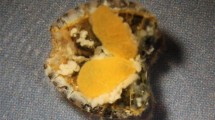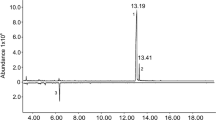Abstract
In this study, we isolated and identified an aggregation-sex pheromone from Monochamus saltuarius, the major insect vector of the pine wood nematode in Korea. Adult males of M. saltuarius produce 2-undecyloxy-1-ethanol, which is known as an aggregation-sex pheromone in other Monochamus species. We performed field experiments to determine the attractiveness of the pheromone and other synergists. More M. saltuarius adult beetles were attracted to traps baited with the pheromone than to unbaited traps. Ethanol and (−)-α-pinene interacted synergistically with the pheromone. Traps baited with the pheromone + (−)-α-pinene +ethanol were more attractive to M. saltuarius adults than traps baited with the pheromone, (−)-α-pinene, or ethanol alone. Ipsenol, ipsdienol, and limonene were also identified as synergists of the aggregation-sex pheromone for M. saltuarius adults. In field experiments, the proportion of females was much higher in the beetles caught in traps than among the beetles emerging from naturally-infested logs in the laboratory. Our results suggest that a combination of aggregation-sex pheromone and synergists could be very effective for monitoring and managing M. saltuarius.





Similar content being viewed by others
References
Abelleira A, Picoaga A, Mansilla JP, Aguin O (2011) Detection of Bursaphelenchus xylophilus, causal agent of pine wilt disease on Pinus pinaster in northwestern Spain. Plant Dis 95:776
Agresta M, D'Arrigo P, Fasoli E, Losi D, Pedrocchi-Fantoni G, Riva S, Servi S, Tessaro D (2003) Synthesis and antiproliferative activity of alkylphosphocholines. Chem Phys Lipids 126:201–210
Álvarez G, Gallego D, Hall DR, Jactel H, Pajares JA (2016) Combining pheromone and kairomones for effective trapping of the pine sawyer beetle Monochamus galloprovincialis. J Appl Entomol 140:58–71
Archambeau A, Miege F, Meyer C, Cossy J (2012) Highly efficient stereoselective catalytic C(sp3)-H insertions with donor rhodium carbenoids generated from cyclopropenes. Angew Chem Int Ed 51:11540–11544
Cardé RT (2014) Defining attraction and aggregation pheromones: teleological versus functional perspectives. J Chem Ecol 40:519–520
Chènier JVR, Philogène B Jr (1989) Field responses of certain forest Coleptera to conifer monoterpense and ethanol. J Chem Ecol 15:1729–1745
Choi YE, Moon YS (1989) Survey on distribution of pine wood nematode (Bursaphelenchus xylophilus) and its pathogenicity to pine trees in Korea. J Plant Pathol 5:277–286
Fauziah BA, Hidaka T, Tabata K (1987) The reproductive behavior of Monochamus alternatus hope (Coloptera: Cerambycidae). Appl Entomol Zool 22:272–285
Fierke MK, Skabeikis DD, Millar JG, Teale SA, Mcelfresh JS, Hanks LM (2012) Identification of a male-produced aggregation pheromone for Monochamus scutellatus scutellatus and an attractant for the congener Monochamus notatus (Coleoptera: Cerambycidae). J Econ Entomol 105:2029–2034
Grnzel M, Hanks L (2003) Contact pheromones as mate recognition cues of four species of longhorned beetle (Coleoptera: Cerambycidae). J Insect Behav 16:181–187
Hanks LM, Millar JG (2013) Field bioassays of cerambycid pheromones reveal widespread parsimony of pheromone structures, enhancement by host plant volatiles, and antagonism by components from heterospecifics. Chemoecology 3:21–44
Ibeas F, Gallego D, Díez JJ, Pajares JA (2007) An operative kairomonal lure for managing pine sawyer beetle Monochamus galloprovincialis (Coleoptera: Cerymbicydae). J Appl Entomol 131:13–20
Ibeas F, Díez JJ, Pajares JA (2008) Olfactory sex attraction and mating behavior in the pine sawyer Monochamus galloprovincialis (Coleoptera: Cerambycidae). J Insect Behav 21:101–110
Ibeas F, Gemeno C, Díez JJ, Pajares JA (2009) Female recognition and sexual dimorphism of cuticular hydrocarbons in Monochamus galloprovincialis (Coleoptera: Cerambycidae). Ann Entomol Soc Am 102:317–325
James R, Tisserat N, Todd T (2006) Prevention of pine wilt of scots pine (Pinus sylvestris) with systemic abamectin injections. Arboric Urban For 32:195–201
Jeon KS, Kim C, Park NC, Hur TC, Hong SC (2011) Effects on control of pine wilt disease (Bursaphelenchus xylophilus) by thinning methods in red pine (Pinus densiflora) forest. J Kor For Soc 100:165–171
Kim GH, Tabayashi J, Takahashi S, Tabata K (1992) Function of pheromones in mating behavior of the Japanese pine sawyer, Monochamu alternatus hope. Appl Entomol Zool 4:489–497
Kim JC, Kim KJ, Kim DS, Han JS (2005) Seasonal variations of monoterpene emission from coniferous trees of different ages in Korea. Chemosphere 59:1685–1696
Kim J, Lee SM, Jung YH, Kwon YD, Kim DS, Lee DW, Park CG (2016) Field evaluation on the synergistic attractiveness of 2-(1-undecyloxy)-1-ethanol and ipsenol to Monochamus saltuarius. Entomol Res 46:31–35
Kishi Y (1995) The pine wood nematode and the Japanese pine sawyer. Thomas Company Limited, Tokyo
Korea Forest Research Institute (2015) Annual report on 2014 NIFOS research project -maintenance and improvement of safe and healthy forest environments. Korea Forest Research Institute, Seoul
Kwon TS, Shin JH, Lim JH, Kim YK, Lee EJ (2011) Management of pine wilt disease in Koea through preventative silvicultural control. For Ecol Manag 261:562–569
Lee SM, Kim DS, Lee SG, Park NC, Lee DW (2009) Selection of trunk injection pesticides for preventive of pine wilt disease, Bursaphelenchus xylophilus on Japanese black pine (Pinus thunbergii). Kor J Pest Sci 13:267–274
Lee SM, Hong DK, Jang SH, Lee KY, Lee CW (2017) Synergistic attraction of pine sawyer Monochamus saltuarius (Coloeptera: Cerambycidae) to monochamol and α-pinene. Entomol Res 47:125–128
Miller DR (2006) Ethanol and (−)-α-pinene: attractant kairomones for some large wood-boring beetles in southeastern USA. J Chem Ecol 32:779–794
Miller DR, Dodds KJ, Eglitis A, Fettig J, Hofstetter RW, Langor DW, Mayfield AE III, Munson AS, Poland TM, Raffa KF (2013) Trap lure blend of pine volatiles and bark beetle pheromones for Monochamus spp. (Coleoptera: Cerambycidae) in pine forests of Canada and the United States. J Econ Entomol 106:1684–1692
Morewood WD, Simmonds KE, Gries R, Allison JD, Borden JH (2003) Disruption by conophthorin of the kairomonal response of sawyer beetles to bark beetle pheromones. J Chem Ecol 29:2115–2129
Mota MM, Braasch H, Bravo MA, Penas AC, Burgermeister W, Metge K, Sousa E (1999) First report of Bursaphelenchus xylophilus in Portugal and in Europe. Nematology 1:727–734
Nakamura-Matori K (2008) Vector-host tree relationships and the abiotic environment. In: Zhao BG, Futai K, Sutherland JR, Takeuchi Y (eds) Pine wilt disease. Springer, Japan
Pajares JA, Álvarez G, Ibeas F, Gallego D, Hall DR, Farman DI (2010) Identification and field activity of a male-produced aggregation pheromone in the pine sawyer beetle, Monochamus galloprovincialis. J Chem Ecol 36:570–583
Pajares JA, Álvarez G, Hall DR, Douglas P, Centeno F, Ibarra N, Schroeder M, Teale SA, Wang Z, Yan S, Millar JG, Hanks LM (2013) 2-(Undecyloxy)-ethanol is a major component of the male-produced aggregation pheromone of Monochamus sutor. Entomol Exp Appl 149:118–127
Phillips TW, Wilkening AJ, Atkinson TH, Nation JL, Wilkinson RC, Foltz JL (1988) Synergism of turpentine and ethanol as attractants for certain pine-infesting beetles (Coleoptera). Environ Entomol 17:456–462
Ryall K, Silk P, Webster RP, Gutowski JM, Meng Q, Li Y, Gao W, Fidgen J, Kimoto T, Scarr T, Mastro V, Sweeney JD (2014) Further evidence that monochamol is attractive to Monochamus (Coleoptera: Cerambycidae) species, with attraction synergized by host plant volatiles and bark beetle (Coleoptera: Curculionidae) pheromones. Can Entomol 147:564–579
Shin SC (2008) Pine wilt disease in Korea. In: Zhao BG, Futai K, Sutherland JR, Takeuchi Y (eds) In Pine wilt disease. Springer, Japan
Song HK, Kim JK (1994) Essential oil component of leaves and resins form Pinus densiflora and Pinus koraiensis. Mokchae Konghak 22:59–67
Teale SA, Wickham JD, Zhang F, Su J, Chen Y, Xiao W, Hanks LM, Millar JG (2011) A male-produced aggregation pheromone of Monochamus alternatus (Coleoptera: Cerambycidae), a major vector of pine wood nematode. J Econ Entomol 104:1592–1598
Ugawa S, Fukuda K (2008) Effect of aerial spraying of insecticide as a control measure for pine wilt disease. Biomed Life Sci 7:389–396
Acknowledgements
This work was supported by a grant from the National Institute of Forest Science (Project No. 0525-20160049, “Research on chemicals that control behavior of vector insect of pine wood nematode”) to IK Park.
Author information
Authors and Affiliations
Corresponding author
Rights and permissions
About this article
Cite this article
Lee, HR., Lee, SC., Lee, D.H. et al. Identification of the Aggregation-sex Pheromone Produced by Male Monochamus saltuarius, a Major Insect Vector of the Pine Wood Nematode. J Chem Ecol 43, 670–678 (2017). https://doi.org/10.1007/s10886-017-0864-6
Received:
Revised:
Accepted:
Published:
Issue Date:
DOI: https://doi.org/10.1007/s10886-017-0864-6




